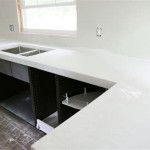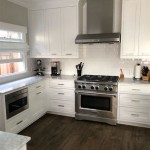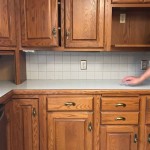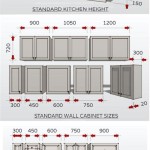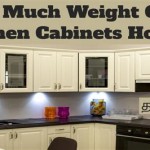Best Kitchen Cabinet Options: A Comprehensive Guide
Kitchen cabinets are a crucial element of any kitchen design, influencing both functionality and aesthetics. Selecting the best kitchen cabinet options requires careful consideration of various factors, including budget, style preferences, durability requirements, and storage needs. This article provides a comprehensive overview of the most common kitchen cabinet options, covering materials, construction methods, styles, and finishes to assist in making informed decisions.
Cabinet Materials: Strength and Style
The material used in cabinet construction significantly impacts its durability, appearance, and cost. Common cabinet materials include solid wood, plywood, particleboard, medium-density fiberboard (MDF), and stainless steel. Each option offers distinct advantages and disadvantages.
Solid Wood: Solid wood is a traditional and highly sought-after material for kitchen cabinets. It offers exceptional strength, durability, and a natural aesthetic appeal. Popular wood species for cabinets include maple, oak, cherry, birch, and hickory. Maple and oak are known for their hardness and resistance to scratches and dents, making them suitable for high-traffic kitchens. Cherry offers a rich, warm color that deepens over time, while birch provides a smooth, uniform surface ideal for painting. Hickory is a particularly durable and visually striking option with prominent grain patterns.
However, solid wood is susceptible to changes in humidity and temperature, which can cause warping, cracking, and expansion. To mitigate these risks, it is essential to properly seal and finish solid wood cabinets and to maintain a stable indoor environment. Solid wood cabinets are also generally more expensive than other material options.
Plywood: Plywood is an engineered wood product composed of multiple layers of wood veneers glued together. It offers superior strength and stability compared to solid wood and is less prone to warping or cracking. Plywood is a popular choice for cabinet boxes and shelves, providing a sturdy and reliable foundation. It is also resistant to moisture damage, making it a suitable option for kitchens and bathrooms.
The quality of plywood varies depending on the number of layers, the type of wood used, and the adhesive employed. Higher-grade plywood with more layers and waterproof adhesives will offer greater strength and durability. Plywood is generally less expensive than solid wood, making it a cost-effective alternative.
Particleboard: Particleboard is another engineered wood product made from wood chips and resin compressed together. It is the least expensive option for cabinet construction but also the least durable. Particleboard is susceptible to water damage and can swell or crumble if exposed to moisture. It is also relatively weak and prone to sagging under heavy loads. Particleboard is generally used for cabinet boxes and shelves in lower-cost cabinets.
While particleboard cabinets can be laminated or veneered to improve their appearance, they are not as visually appealing as solid wood or plywood options. Particleboard is best suited for kitchens with low moisture levels and minimal storage requirements. It is crucial to avoid excessive moisture exposure to prolong the lifespan of particleboard cabinets.
Medium-Density Fiberboard (MDF): MDF is an engineered wood product similar to particleboard but with a smoother and more uniform surface. It is made from wood fibers and resin compressed under high pressure and heat. MDF is more dense and durable than particleboard and less prone to chipping or cracking. It is an excellent surface for painting as it does not have a wood grain pattern.
MDF is commonly used for cabinet doors and drawer fronts. However, like particleboard, MDF is susceptible to water damage and should be protected from excessive moisture. MDF is more expensive than particleboard but less expensive than solid wood or plywood. It offers a good balance of affordability and durability.
Stainless Steel: Stainless steel cabinets are commonly found in commercial kitchens and are gaining popularity in modern residential kitchens. Stainless steel is highly durable, resistant to corrosion, and easy to clean. It provides a sleek and contemporary aesthetic. Stainless steel cabinets are also hygienic and resistant to bacteria growth.
However, stainless steel cabinets can be expensive and may show fingerprints and smudges easily. They can also be noisy when items are placed inside. Stainless steel cabinets are best suited for kitchens with a modern or industrial design aesthetic.
Construction Methods: Framed vs. Frameless
Kitchen cabinets are typically constructed using one of two methods: framed or frameless. These construction methods affect the cabinet's appearance, functionality, and installation process.
Framed Cabinets: Framed cabinets, also known as face-frame cabinets, feature a frame around the cabinet box opening. This frame provides additional stability and strength to the cabinet. The doors and drawers are attached to the frame. Framed cabinets are typically more traditional in style and offer a wide range of design options.
The frame can be either flush with the cabinet box or inset, where the doors and drawers are set flush with the frame. Framed cabinets are generally easier to install than frameless cabinets because the frame provides a reference point for alignment. However, the frame can reduce the usable storage space inside the cabinet.
Frameless Cabinets: Frameless cabinets, also known as European-style cabinets, do not have a frame around the cabinet box opening. The doors and drawers are attached directly to the cabinet box edges. Frameless cabinets offer a sleek, modern aesthetic and maximize usable storage space. They are popular in contemporary kitchen designs.
Frameless cabinets require precise construction and installation to ensure proper alignment and stability. They are generally more expensive than framed cabinets. Frameless cabinets offer a clean, minimalist look and are easy to clean due to the absence of a frame. They are well-suited for kitchens with limited space or a desire for maximum storage capacity.
Cabinet Styles: From Traditional to Modern
Kitchen cabinets are available in a wide variety of styles to suit different design preferences. Common cabinet styles include traditional, transitional, modern, and farmhouse.
Traditional Cabinets: Traditional cabinets feature ornate details, raised-panel doors, and decorative hardware. They often incorporate elements such as crown molding, fluted pilasters, and intricate carvings. Traditional cabinets are typically made from solid wood or wood veneers and are finished with rich stains or glazes.
Traditional cabinets are well-suited for kitchens with a formal or classic design aesthetic. They evoke a sense of warmth, elegance, and timelessness. Traditional cabinets require regular maintenance to preserve their intricate details and finishes.
Transitional Cabinets: Transitional cabinets blend elements of traditional and modern styles. They feature clean lines and simple profiles, but may also incorporate some decorative details, such as raised-panel doors with a less elaborate design. Transitional cabinets are typically made from a variety of materials, including solid wood, plywood, and MDF.
Transitional cabinets are versatile and can be adapted to a wide range of kitchen designs. They offer a balance of functionality and aesthetics. Transitional cabinets are a popular choice for homeowners seeking a timeless yet updated look.
Modern Cabinets: Modern cabinets feature sleek lines, minimalist designs, and flat-panel doors. They often incorporate materials such as stainless steel, glass, and laminate. Modern cabinets are typically finished with high-gloss paints or veneers. They emphasize functionality and simplicity. Modern cabinets are well-suited for kitchens with a contemporary or minimalist design aesthetic.
Modern cabinets offer a clean, uncluttered look and are easy to clean. They require precise installation to maintain their sleek lines and seamless appearance. Modern cabinets create a sense of spaciousness and sophistication.
Farmhouse Cabinets: Farmhouse cabinets evoke a rustic and charming aesthetic. They often feature shaker-style doors, beadboard panels, and distressed finishes. Farmhouse cabinets are typically made from wood or wood veneers and are finished with light-colored paints or stains. They incorporate elements such as apron-front sinks, open shelving, and vintage-inspired hardware.
Farmhouse cabinets are well-suited for kitchens with a country or cottage-style design aesthetic. They create a warm, inviting, and comfortable atmosphere. Farmhouse cabinets often incorporate reclaimed materials or repurposed furniture to enhance their rustic charm.
Cabinet Finishes: Protecting and Enhancing
The finish applied to kitchen cabinets protects the material and enhances its appearance. Common cabinet finishes include paint, stain, laminate, and veneer.
Paint: Paint is a versatile finish that can be applied to a variety of cabinet materials, including wood, MDF, and laminate. It offers a wide range of color options and can be customized to match any design scheme. Painted cabinets are easy to clean and maintain. The durability of painted cabinets depends on the quality of the paint and the application process. High-quality paints with a durable topcoat will resist chipping, scratching, and fading.
Stain: Stain is a finish that penetrates the wood and enhances its natural grain patterns. It offers a range of color options, from light and natural to dark and rich. Stained cabinets require a clear topcoat to protect the wood and provide a durable finish. Stained cabinets are typically used on solid wood or wood veneer cabinets to highlight their natural beauty.
Laminate: Laminate is a synthetic material that is applied to a substrate, such as particleboard or MDF. It offers a durable, scratch-resistant, and moisture-resistant finish. Laminate is available in a wide range of colors, patterns, and textures. Laminate cabinets are easy to clean and maintain. They are a cost-effective option for kitchen cabinets.
Veneer: Veneer is a thin layer of wood that is applied to a substrate, such as plywood or MDF. It offers the look and feel of solid wood at a lower cost. Veneer cabinets require a clear topcoat to protect the wood and provide a durable finish. Veneer cabinets are typically used in conjunction with other materials, such as solid wood edges or moldings.

64 Kitchen Cabinet Design Ideas 2024 Unique Styles

How To Find The Best Kitchen Cabinets 2024 Guide Forbes Home

11 Best Kitchen Cabinets In 2024 Our Top Picks

Best 21 Kitchen Cabinet Ideas In 2024 Oppein

Top 10 Characteristics Of High Quality Kitchen Cabinets Premier Kitchens And

7 Best Kitchen Cabinet Materials To Protect You From Poor Quality Horrors

Kitchen Wardrobe Cabinet Ideas For Your Home Designcafe

Discover 66 Stunning Kitchen Cabinet Ideas For A Stylish Makeover Interior Design Cabinets

20 Top Kitchen Design Ideas That Will Inspire You Oppein

15 Stunning Kitchen Cabinet Designs In Singapore With 5 Essential Tips
Related Posts


